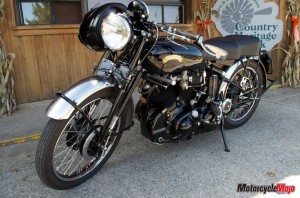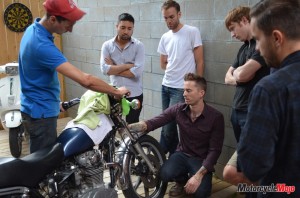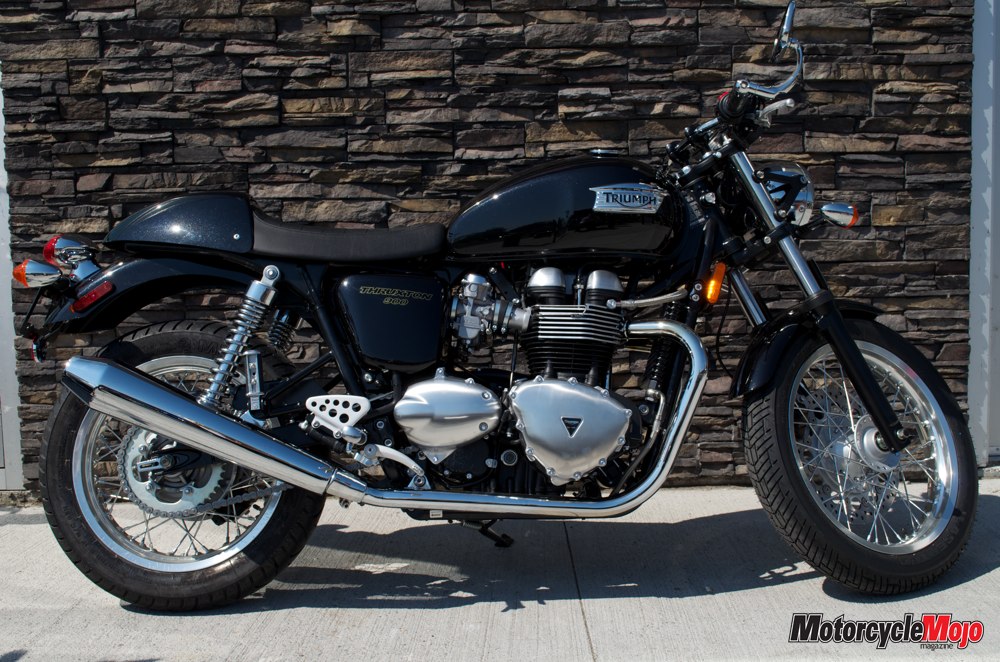With life moving at a feverish pace and technology controlling people’s lives, it just might be time to slow down and get your hands dirty – and then ride.
Many artists through the years have spoken of the creative process of “removing the things that don’t belong,” until the art piece reveals itself. For a sculptor it would be extraneous bits of stone, to a writer it’s words that don’t add value or understanding, for a martial artist, it’s removing unnecessary movement. To many of us, motorcycles are certainly works of art, and if there is any style of bike building that personifies this artistic process, it is the café racer, all starting in 1950s England.
The term “café racer” refers to both the rider and the style of the bike. In 1950s London, if you were a young lad listening to rock-n-roll and wanted the fastest wheels your money could buy, you bought a motorbike. They didn’t have the cash to hot-rod V8s like we did over here, so they’d hot-rod their bikes: Triumphs, Nortons, BSAs, maybe a Vincent if you were lucky. Free time was spent hanging around the cafés, waiting for a challenge to race. Often it involved covering a specific distance and getting back to the café before the song was over on the jukebox, hopefully hitting the magic “ton,” or 100 mph. As part of their performance improvements, they’d drop the handlebars and strip the bikes of anything that wasn’t essential. This became the café racer look.
For the longest time, I’ve been pining for a café bike. I can remember building plastic models of Bonnevilles and Commandos at the kitchen table long before they were considered classics, and in my young mind, just knowing that they were pretty much right. I don’t feel that way about my eminently practical sport tourer, so I’m always on the lookout for that particular form of rolling sculpture, the café racer, and for a long time, it was always “look at that lucky old guy on that fabulous Brit classic.” But for some time now, I’ve been seeing young guys, and some women, sporting three-quarter helmets, tattoos and sneakers on more modern Brit, European and Japanese bikes built in the café tradition. How did that happen?
 Haven’t these kids seen Long Way Round? Don’t they watch American Chopper? Wild Hogs? Shouldn’t they be astride tire-smoking Gixxers and Ninjas?
Haven’t these kids seen Long Way Round? Don’t they watch American Chopper? Wild Hogs? Shouldn’t they be astride tire-smoking Gixxers and Ninjas?
How did the café become cool again with young hipsters? Perhaps because it’s none of the above . . .
Because enquiring minds want to know, I decided to go undercover and explore the world of young hipster café bike owners. Fortunately, with my boyish good looks and freshly pressed khakis, I was able to blend right in with this new breed of ridin’ and wrenchin’ bikers. Sort of.
It’s a warm Thursday night in the up-and-coming west-end area of Ossington and Queen Street West in Toronto. I’m at Town Moto (www.townmoto.com) for one of their Tech Nights, held on the patio behind the store. This is the second one they’ve held since Andrew McCracken, 31, and Marika Thoms, 29, opened the shop in June 2012. Tonight, Andrew and Jamie Pentland, an employee of the shop, are showing a group of 20-somethings how to bleed brakes and clean and adjust chains on a couple of café-style bikes. In front of the store are parked a selection of participants’ bikes, including a modern Bonneville, two Thruxtons and an “old-skool” Harley project bike with a well-aged but refreshed Sportster V-twin in it.
It’s a bit of a clubhouse atmosphere back on the patio, but not a boys club. The owner of the Bonneville is a young woman who is keenly taking in the demo. Questions are asked and answered. Soft drinks are consumed, and after the demo, the conversation continues among the group, all about bikes. But there’s no discussion of racing to a café.
In conversation with tattoo-sleeved and thoughtful Andrew, later, I find he’s not too keen on being called the “new breed” of café racer. He’s not into labelling what he’s doing with his bikes, an ’07 Bonneville daily rider and a ’75 CB 750 project bike. He just likes bikes, and they’re fun to ride.
 “I like all kinds of bikes. I’d love a BMW GS1200, and a lot of other bikes, but can’t afford them. For me, it’s just about having a nice bike that I can afford, work on and ride. I’m just a motorcycle guy.”
“I like all kinds of bikes. I’d love a BMW GS1200, and a lot of other bikes, but can’t afford them. For me, it’s just about having a nice bike that I can afford, work on and ride. I’m just a motorcycle guy.”
He, like most of the young people I talked to, just like the simplicity and stripped-down aesthetic of the café style. “The engineering is pretty simple, and that’s what I like.”
How’d he get here? “I started with an old Honda, because that’s what I could afford, and when it broke, I had to figure out how to fix it. I’m not a mechanic, I’m a graphic designer.” And co-owner of a very cool shop that sells old-school riding gear and accessories that would appeal to anyone enamoured of the café style. He sees a lot of city riders, young guys and girls who buy old bikes and fix them up. But he gets more “mature” customers in the store as well. “Some of the older guys come in and they just light up,” says Andrew. They have cool stories about the old days and they like to see the stuff in the shop that they can only get through magazines and catalogues now.
But what is it about the café bike style that speaks to the new generation? “Some people see a café bike and just like it and don’t even know why. The simplicity and the fact that it’s something they can work on themselves just speaks to them.”
“That’s what happened to 24-year-old Harry Wen. He lives in Port Elgin, Ontario, about three hours from Toronto. He was on a trip to Vancouver when he saw his first café-style bike. “As soon as I saw it, I knew I had to build one.” He went home and found a stock ’75 Honda CB 550 and built his own café racer, right down to the rattle-can paint job. “I just like the stripped-down look, and I like that I ride something that I built myself. It’s my first bike.” That’s right. His first-ever bike is a very respectable, home-built café racer, which he proceeded to ride more than 20,000 km in his first year. That’s a lot of riding. Says Harry, “It’s just fun to ride.” Does he hang out with other café bike owners? “No, I don’t know anyone else who has one. You don’t see them in Port Elgin.”
Andrew and Harry are representative of virtually all of the riders I spoke to who are in their twenties and thirties. They don’t consider themselves “café racers,” they don’t belong to clubs, they don’t really do organized rides. Their whole style is simple and earthy, right down to the jeans and T-shirts that appear to be common to this crowd. They like the style and mechanical purity of the café, and Andrew spoke of a certain romantic attachment to the idea of a café bike as much as the fulfillment of owning, wrenching and riding one. It’s the mysterious allure of the café aesthetic.
Fast-forward slightly to a hot, humid and smoggy weekend in August, and it’s the premiere café racer event of the Toronto season: Mods n’ Rockers (www.modsandrockerstoronto.com). This is the place to be if you want to see the kind of bikes that one normally only sees in magazines: beautifully crafted cafés, meticulously restored classics, as well as a great selection of cool old and new daily riders, some home-built, all parked in the private parking area of The Duke, an old landmark bar. It’s an “all-ages” crowd, anywhere from 20s to 60s I’d say, maybe even 70s, and some of the bikes are just as old.
Outside, I speak with one of the organizers. Tall, slim and striking-looking, dressed all in black, 55-year-old Klaus Kaak has been involved in Mods n’ Rockers for years, and with café bikes since his days in the Hamburg, Germany, scene in the 1970s and 1980s. He’s definitely a Rocker, and one of his four bikes is a ’71 Norton Commando done in the café style. “It’s about more than just the bikes for me. It’s the young people, the fashion, the lifestyle. I enjoy the young urbanites.”
Inside The Duke, the east-end terminus of the early afternoon crosstown ride and home to the live entertainment and refreshment portion of the day, it’s not the “period” music I had anticipated. No-one is performing Ferry ’Cross the Mersey, but a band called The King Bees, who bill themselves as “the Ramones of Surf” are blasting through an excellent, guitar-heavy instrumental dedicated to the late, great Dennis Hopper. How often do you get a chance to hear something like that? Somehow, it fits perfectly with the rest of the eclectic vibe that this event has evolved into over the years, and the audience is enthusiastic.
The participants are primarily men of all ages, with a healthy sprinkling of women, some riding in on their own bikes, and some there, as one woman put it, “purely for decoration.” Regardless, the turnout is great, with some 160 bikes in the lot and more than 240 people enjoying the event, some even in period costume. Once again, everyone I talk to, regardless of age, is friendly and enthusiastic about the bikes. Great crowd.
Among them is 40-year-old Andy Cox, who rode in on a beautiful, Triumph home-built custom powered by a ’76 T140 engine surrounded by a completely hand-built frame. He’d wanted to build a bike for a long time, and his father-in-law had been sitting on this motor for years. Finally, Andy pried it out of him (though he won’t confess to how), and the build began. He ended up with a bike that’s part bobber, part café, and all gorgeous in its sparkling red-and-white paint. Again, he just liked the aesthetics of these lean machines, and he and a friend, Grant Schwartz, made most of the components, right down to lacing his own wheels and adding a CCM chain guard (Andy owns a bicycle shop). But one of the real gems on the bike, according to Andy, is the ’66 Euro tank. An old gentleman had that tank for years and was never going to let go of it. Andy tried and tried. But once the fellow saw what Andy was doing with the build, he handed it over to the very appreciative new owner.
Andy, a member of the Canadian Vintage Motorcycle Group (CVMG), talks of the help and advice he’s received from older owners. “Everyone is willing to help out, and I’ve made a lot of great friends. And the older classic-Brit riders are excited to see the young people get into the hobby, no matter what they ride.” A number of the members ride café-style bikes.
Lest I give the impression that this is some sort of Toronto-centric phenom, 28-year-old Brett Beadle of Vancouver can lay that idea to rest (check out his blog at www.manalivemotorcycles.tumblr.com). Says Brett, “There’s a lot of interest in Vancouver among the 25- to 35-year-old group. We can ride pretty much all year round. There’s an amazing range of customs, including a lot of cafés . . . there are people who have never owned a bike before who think they’ve gotta get in on it because they’re missing out on something.”
But is it hands-on wrenching? “Oh yeah, the appeal of older bikes is that you can maintain them. New bikes, you take them to the dealer and they plug them in to figure out what’s wrong. You spend a lot of time taking off fairings.”
Brett is a mechanic, but doesn’t work at it. He and his business partner TJ, 33, are opening a men’s clothing and moto-apparel store in Vancouver called The Shop. That’s his full-time gig. But he recalls building his first bike in his grandmother’s basement, and just going from there. He now has shared garage space where he can hang with friends, work on bikes and have a beer. But what about women? Is he seeing more of them riding these bikes? “Yeah, I’m seeing more, but still relatively small numbers. We had an event recently with maybe 70 bikes, and about five were ridden by women. I can see that it can be a bit intimidating, you show up and you see a bunch of tattooed guys drinking beer, but we’re pretty inclusive and everyone is pretty laid back.”
I have to agree with Brett on that point. Notwithstanding my neatly pressed khakis (ahem), every young, tattoo-bedecked rider I’ve met has been friendly, open, happy to talk about bikes, and pretty mellow. Must be the fumes? That always makes me feel good.
So, what’s the difference between the Toronto and Vancouver scenes? According to Brett, with the better riding weather, they seem to have a lot more organized rides, and it’s so easy to get out of town that they can start ripping it up pretty quickly (but not at 300 km/h). And he thinks that they have better access to south-of-the-border bikes, so a lot of people bring old bikes up from the States. Lucky buggers!
So what can be learned about a group of young people who are in love with a style that originated 60 years ago on another continent, long before they were born? In Canada, motorcycles are generally an emotional purchase. And movies like Long Way Round and Easy Rider fuel our emotions and desires in a big way. Who wouldn’t want to be riding with Captain America and Billy to discover America, bedroll strapped to their sissy bar?
But these young folks aren’t following the popular culture in riding adventure bikes, crotch rockets or choppers. They are making their own way, quite literally, by building their bikes, their way. Simple. Pure. They’re not spending a lot of money for some overwrought trailer queen. They’re not afraid to get their hands dirty and experiment and learn about the bikes they ride so that they can fix them when they break, and they take pride in riding something built with their own hands.
Even though they weren’t personally there, I sense some sort of nostalgia for the old days and ways among these riders. Maybe with the complexities of the modern world, they need a break from their climate-controlled towers and smart phones to create something tangible with nothing more, in most cases, than hand tools. Something that they can breathe life into, climb on, and feel free. Like the generations that preceded them, they somehow intuit the simple elegance of the café. For them it epitomizes the romantic imagery of motorcycling on the open road, but not as Hollywood has dictated. It’s the direct opposite of their urban, technology-overloaded daily existence.
Or maybe, as they said, they just like the bikes.”























































































